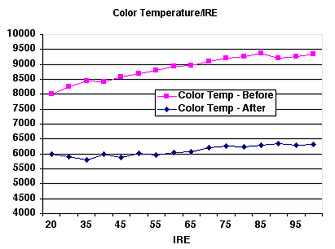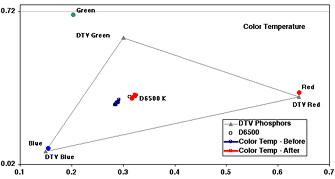Marantz PD5010D 50-Inch Plasma HD Monitor Page 2
 Next, I ran my SD-9100 via its progressive-scan component video outputs, and the picture cleaned up beautifully. The DVD player's 3:2 pulldown eliminated the jaggy artifacts, and the PD5010D's scaler upconverted the 480p signal to the panel's native resolution of 1,365 by 768. So, I got the best of both worlds: an artifact-free picture from the progressive-scan player and the much higher resolution of the plasma panel. Using a good progressive-scan DVD player with the PD5010D will definitely take care of DVD playback; however, if you want all of your NTSC sources to benefit from 3:2 pulldown, you should consider a good outboard scaler with an output rate that matches the panel's 1,365-by-768 resolution. Affordable scalers that deliver the video goods include the Crystal Image VS 2.0 and Runco's new PFP-7, both of which offer a slew of scan rates to choose from. The Crystal Image sells for $2,500 and the Runco PFP-7 for $4,995.
Next, I ran my SD-9100 via its progressive-scan component video outputs, and the picture cleaned up beautifully. The DVD player's 3:2 pulldown eliminated the jaggy artifacts, and the PD5010D's scaler upconverted the 480p signal to the panel's native resolution of 1,365 by 768. So, I got the best of both worlds: an artifact-free picture from the progressive-scan player and the much higher resolution of the plasma panel. Using a good progressive-scan DVD player with the PD5010D will definitely take care of DVD playback; however, if you want all of your NTSC sources to benefit from 3:2 pulldown, you should consider a good outboard scaler with an output rate that matches the panel's 1,365-by-768 resolution. Affordable scalers that deliver the video goods include the Crystal Image VS 2.0 and Runco's new PFP-7, both of which offer a slew of scan rates to choose from. The Crystal Image sells for $2,500 and the Runco PFP-7 for $4,995.
I also watched a good deal of HDTV material via my recently installed DISH Network system, and HDTV does look quite good on the PD5010D. However, even with the incredible resolution of a 1080i signal, dark scenes still suffered from the aforementioned black-level and low-level-noise problems. Nevertheless, the recent release of Billy Crystal's 61* on HBO's high-def channel looked really good. Detail in people's hair and faces was downright spooky on HDTV broadcasts.
The PD5010D's value isn't bad in the context of what's on the market. At $19,995, it's neither the least nor the most expensive 50-inch plasma, falling somewhere in the middle of the price range. It exhibits considerably less false contouring than what I've seen on other models, and black-level performance seems to be on par with the competition. That makes this a reasonably good value in 50-inch plasma sets.
If you're looking for the ultimate in home theater performance, plasma technology is not for you. However, if you're looking for a big-screen set that can handle HDTV sources for a living room or family room, then plasma could be the right choice, and the Marantz PD5010D is among the best 50-inch models on the market.

Highlights
• 1,365-by-768 resolution for HDTV capability
• Adjustable gray bars prevent 4:3 burn-in
HT Labs Measures: Marantz PD5010D 50-Inch Plasma HD Monitor


The top chart shows the gray scale of the Marantz plasma monitor relative to its color temperature at various levels of intensity, or brightness (20 IRE is dark gray; 95 IRE is bright white). As you can see, the gray scale as set by the factory, in the most accurate menu setting, measures 8,500 Kelvin with dark images and leans more toward 9,200 K with brighter images. After making adjustments using the Photo Research PR-650, the gray scale measures within 700 K of D6500, the accurate setting, across the entire range. The bottom chart shows the gray scale (or color temperature) relative to the color points of the display's red, green, and blue CRTs. The blue and red color points match relatively closely to those specified by SMPTE. The green primary color is considerably more greenish-yellow. The gray scale slants blue before calibration and is more accurate, if slightly red, afterward. The light output was approximately 38 foot-lamberts with a 15%-white window, representing normal video material. A full-white field measured 11 ft-L. The monitor displays at least 470 horizontal lines (per picture height) with NTSC sources.—MW
- Log in or register to post comments












































